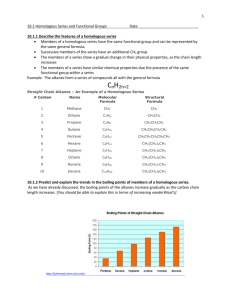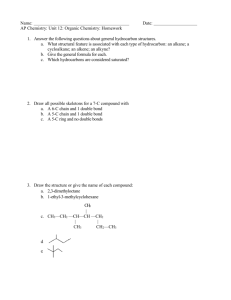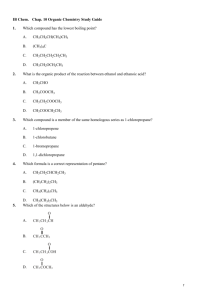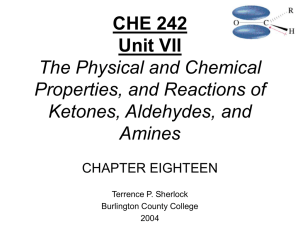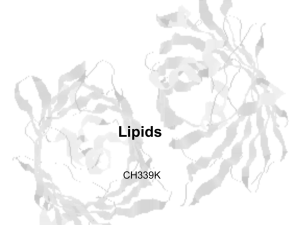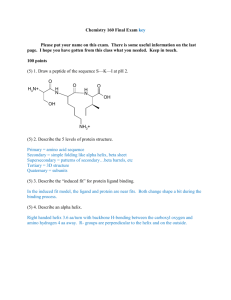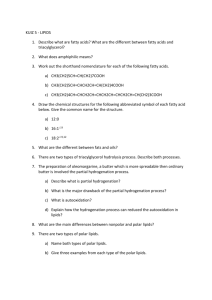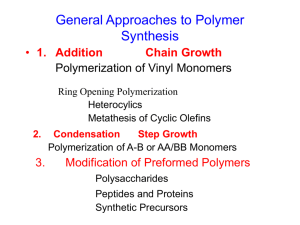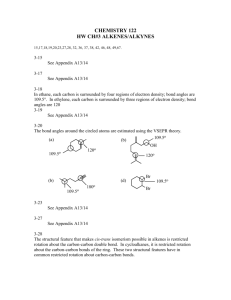Bioinorganic chemistry
advertisement
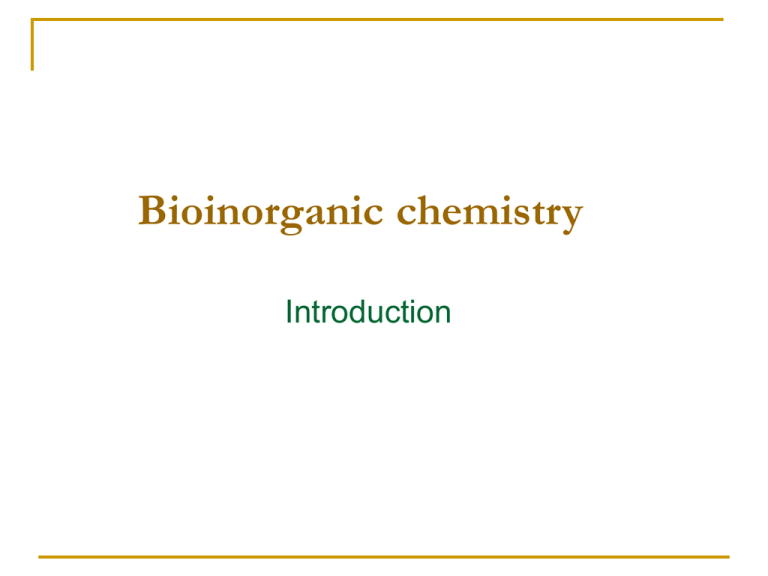
Bioinorganic chemistry Introduction Bioinorganic chemistry as a highly interdisciplinary research field biochemistry (micro-) biology Inorganic chemistry Bioinorganic chemistry physics physiology pharmacology toxicology Evolution of life essential elements Earth solidified ~ 4 billion years ago 81 stabile elements Elements of the living organism: 1. Elements in large scale: 11 elements H, C, N, O, Na, Mg, P, S, Cl, K, Ca 2. Elements in small scale: 7 elements Mn, Fe, Co, Cu, Zn, I, Mo 3. Elements of a few species: 7 elements B, F, Si, V, Cr, Se, Sn Periodic Table bulk eliments for some species trace eliments Concentration and physiological effect E ffect C onc Lack of elem ent (D eath) D eficiency (D isease) O ptim al supply E xcess (D isease) Toxic dose (D eath) Metals Metals essential for life: The role for most is uncertain Na, K, Mg, Ca V, Cr, Mn, Fe Co, Ni, Cu, Zn Mo, W General roles of metal ions in biology Na, K: Charge carriers Osmotic and electrochemical gradients Nerve function Mg, Ca: Enzyme activators Structure promoters Lewis acids Mg2+: chlorophyll, photosynthesis Ca2+: insoluble phosphates Alkali metals Terrestrial distribution: Li 0.060 nm Na K Rb 0.133 nm Cs 0.095 nm Distribution in vivo: (Li) Na K (Rb) Fr ionic radii Role: Na+ Extracellular fluid Osmotic balance „sodium pump” Acid-base balance Conformation of proteins nucleic acids Electrical impulse of nerve system Mg2+ 3Na+ic + 2K+ec + ATP4- + H2O 3Na+ec + 2K+ic + ADP3- + HPO42- + H+ K+ Enzyme activator Conformation of proteins RNA (replication) Secretion of gastric acid Transmembrane potentials! Complexes of alkali metals (Na+, K+) Cyclic antibiotics Valinomycin Monactin Nonactin polyethers cryptands synthetic The valinomycin-potassium complex D -V a l H L L -V a l O O L -V a l L O K+ O H D -V a l O O D -V a l H L -V a l L The nonactin-potassium complex CH3 O CH3 O O H 3C O H 3C O K O CH3 O CH3 O O CH3 O CH3 O Macrocyclic ligands O O O O O O CH2 CH2 O 4 O CH2 CH2 O 4 O n+ N O O O O O O n+ N + M O N O O O M O O N Alkaline Earth Metals Terrestrial distribution: Be Mg Distribution in vivo: Be, Ba TOXIC! Sr (not particularly toxic) 90Sr accumulates in bones Ca Sr Mg Ca Ba Ra Alkaline Earth Metals Mg2+ Plants chlorosis CHLOROPHYLL nervous system (tetany) active transport (intracellular) enzyme activator (e.g. ATP-ase) Ca2+ antagonist Ca2+ Inhibits Mg2+-activated enzymes Extracellular: clotting (10-3M) Ca2+ prothrombin thrombin-fibrinogen-fibrin C H2 R CH H3C C H2 N C H3 N Mg N N Chlorofill C H3 H3C O O H3C OOC O The mechanism of the phosphate hydrolysis R R R O O P P O M OH O O O M 2+ 2+ O O O O O O OH M 2+ OH Transition Metals Fe, Cu, Mo: Electron-transfer Redox proteins and enzymes Oxygen carrying proteins Nitrogen fixation Zn: Metalloenzymes Structure promoters Lewis acid Not a redox catalyst! Other metal ions: less well defined and more obscure roles Fe(II), Fe(III): Essential for ALL organisms In plants: iron deficiency In human body: 4-5 g Uptake: ~ 1 mg/day In human body 75% Hem-iron Hemoglobin Myoglobin Cytochromes Oxidases, P-450 25% Non-hem-iron Rubredoxins Ferredoxins Cu(I), Cu(II) Plants Animals Electron transfer O2-carrying Protection of DNA from O2- Cu-proteins and enzymes Cytochrome oxidase O2 H2O Tyrosinase, phenol oxidase ox. of phenols Ceruloplasmin Fe(II) Blue proteins Electron transfer Superoxide dismutase Elimination of O2- Hemocyanin O2 transport Fe(III) Superoxide Dismutase SOD-Cu2+ + O2.- SOD-Cu1+ + O2 SOD-Cu1+ + O2.- + 2H+ SOD-Cu2+ + H2O2 Role of Zn2+ : deficiency: disturbances of repr. system dwarfism skin lesions skeletal abnormalities (Cys – X – Cys)7 x=nonaromatic amino acid Zn – metalloenzymes: 80! Zn activated enzymes: 20! (H2O)(1-2) N S (H2O)(1-2) Zn O Zn N C O S(N) S(N) Zn N S S S Function of Zn in metalloenzymes 1. Structure-promoter 2. Substrate binder 3. Lewis acid Outlined structure of apoferritin Iron(II)-protoporfirin IX-complex (HEM) CH2 H 3C HC CH CH N H 3C CH3 N Fe N CH H 2C CH2 N HC CH OOC H 2C H 2C CH3 COO CH2 Myoglobin Hemoglobin Catalytic cycle of P-450 enzymes H2O S ROH RH H2O Fe III S S H 2O IV III Fe Fe O R H RH +A H2O e+ AO 2 H+ S S III Fe Fe S O RH II O III Fe RH O e- RH O 3O 2 H H H C N C O Zn HN N N H is-19 6 NH O CH2 C H is-6 9 O CH3 H2 C H2 C H C H S (C ys) O Zn S (C ys) N (H is) CH2 G lu-72 Zink(II) in the active centre of carboxipeptidase-A The active centre of the alcohol dehydrogenase Coordination environment of the copper centre in azurin Reversible oxygenation of hemocyanin H is H is H is H is H is Cu I Cu 3 + O2 Cu - 3O 2 H is H is I H is H is O O II H is Cu L II H is H is Structure of dimetal centre in Cu-Zn superoxide dismutase S Fe Fe Fe Fe S S S S S Fe S Fe S S Fe S Fe S Mo S Supposed structure of Fe-S-Mo cofactor of nitrogenase 12 ATP 12 ATP 3 NADH + 3H+ 3 NAD+ 3 Ferredoxin (oxidized) 3 Ferredoxin (reduced) Fe protein (reduced) Fe protein (reduced) N2 Fe-Mo protein (oxidized) 12 ATP Fe protein (oxidized) Fe protein (oxidized) 12 ADP + 12 Pi N2 Fe-Mo protein (oxidized) Fe-Mo protein (reduced) 2 NH3 6 H+ The supposed reaction mechanism of dinitrogenase Coordination environment of the Cr3+ centre in the glucose tolerance factor COOH N L L Cr L L N HOOC



